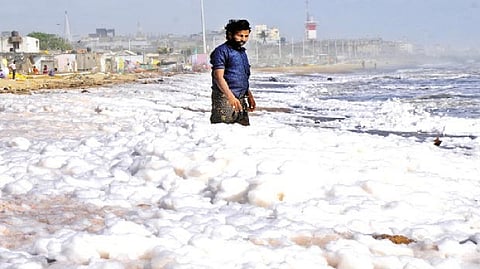

CHENNAI: While directing Metro Water and Sewerage Board (Metro Water) to complete 'Illamthorum Inaippu' scheme to prevent sewage outfall into rivers, the southern bench of National Green Tribunal (NGT) has ordered Tamil Nadu Pollution Control Board (TNPCB) to monitor sea water quality to prevent frothing incidents near shores.
Hearing a suo motu case regarding white foam incidents near Napier Bridge, the NGT said that the noxious froth which was hitting the coast is attractive and fun to play within the city beach, but the truth behind the same is that foam is toxic and it is by and large the result of discharge of untreated sewerage into the water bodies. The foaming happens when the pollutants in the sewage from the river mix with the saline coastal water.
Moreover, the NGT issued notices to Chennai Corporation, Metro Water, TNPCB, Tamil Nadu Coastal Zone Management Authority and others to file report on the issue and committee was formed with officials from the concerned departments to ascertain the source of foam and the reason for its recurrence apart from to suggest remedial measures to avoid such things in future.
The Committee was also directed to conduct water analysis test to ascertain the water quality and contents of the water.
Report submitted by the committee disclosed coastal foaming is mainly due to sewage laid in high organic matter, the phosphate content and others. "If phosphate content is high, it indicates the presence of detergent while ammonia suggests discharge of raw sewage.
"The microbiological studies also have indicated high values of faecal coliforms throughout the year which confirms the fact that discharge of sewage water into river which conflagrates with sea creates coastal foaming when there is heavy rainfall or the coastal water is agitated by winds and waves. The foaming in the coastal area is an indication that sewage should not be let into the sea posing risk to the marine ecosystem and the sea organisms living therein, " the Tribunal observed.
Disposing the case, the NGT directed the Metro Water to complete pending sewerage projects and 'Ilamthorum Inaippu' scheme and TNPCB to conduct periodic inspection regarding sewage outfall.
Visit news.dtnext.in to explore our interactive epaper!
Download the DT Next app for more exciting features!
Click here for iOS
Click here for Android